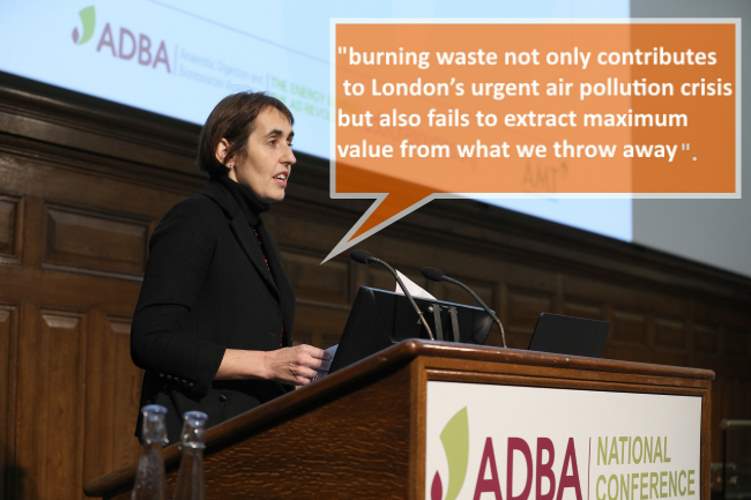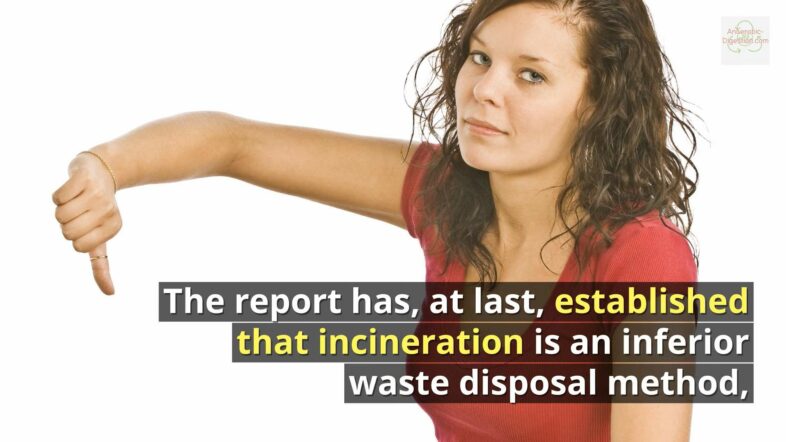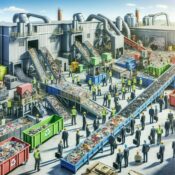The “disadvantages of burning waste“, is always a topic of great interest to those who live near proposed new incinerators. Now it is believed, more will be built. At last in the UK, the government has realised that additional waste treatment facilities are essential for the UK (in or out of the EU) if targets declared again. This has happened since the start of the year, with publication of the UK's 25 Year Environment Plan. Further recycling rate increases and landfill diversion are to be achieved. However, the campaign needs to start now if the round of new MSW waste treatment capacity, in England, isn't going to be very much dominated by new incineration plants.
At the same time the government has declared its support for the anaerobic digestion process, both for its renewable energy but also for matters such as farm slurry management, so any programme of investment in waste technology plants should surely also incorporate the much superior technology of organic waste treatment by anaerobic digestion.
With these two thoughts in mind we have compiled a number of internet views on the subject of “Disadvantages of Burning Waste and Why Not More Biogas”, which we quickly explain in the video below. when you have watched the video, DON'T MISS the more detailed discussion of this subject, and SCROLL DOWN to read it lower-down on this page:
The main points made in the report, which are of particular interest to the AD Industry, are as follows:
- Report calls incineration one of ‘least desirable forms’ of waste management
- Report calls for food waste to be separated and sent to anaerobic digestion facilities to extract full value
- AD industry body says report ‘strengthens case for mandatory separate food waste collections’.
The UK’s anaerobic digestion (AD) industry has welcomed a report published today by the London Assembly’s Environment Committee that describes incineration of household wasteas one of the ‘least desirable forms of management in the waste hierarchy’.
The report states that the amount of UK waste sent for incineration has more than doubled in the last decade, reaching nearly two million tonnes in 2017. It also notes [as disadvantages of incineration], that:
- burning waste takes materials out of the circular economy,
- releases carbon into the atmosphere, and
- may have negative health effects.
The report goes on to say that because not all London boroughs offer separate food waste collections, food waste is being burnt rather going to other processes which are more environmentally beneficial, such as AD, which recycles food waste into renewable energy, low-carbon transport fuel, and nutrient-rich biofertiliser.
For the full article version on this subject click here.
More Facts on the Disadvantages of Burning Waste
 * Sanitary landfill is the cheapest satisfactory means of disposal, but only if suitable land is within economic range of the source of the wastes; typically, collection and transportation account for 75 percent of the total cost of solid waste management.
* Sanitary landfill is the cheapest satisfactory means of disposal, but only if suitable land is within economic range of the source of the wastes; typically, collection and transportation account for 75 percent of the total cost of solid waste management.
* In a modern landfill, refuse is spread in thin layers, each of which is compacted by a bulldozer before the next is spread. When about 3 m (about 10 ft) of refuse has been laid down, it is covered by a thin layer of clean earth, which also is compacted.
* Pollution of surface and groundwater is minimised by lining and contouring the fill, compacting and planting the cover, selecting proper soil, diverting upland drainage, and placing wastes in sites not subject to flooding or high groundwater levels.
* Gases are generated in landfills through anaerobic decomposition of organic solid waste. If a significant amount of methane is present, it may be explosive; proper venting eliminates this problem. via Waste Disposal – Problem
Advantages of Anaerobic digestion of MSW
The anaerobic digestion of food waste has many benefits, including:
• Climate Change Mitigation – Food waste in landfills generates methane, a potent greenhouse gas.
Diverting food waste from landfills to wastewater treatment facilities allows for the capture of the methane, which can be used as an energy source. In addition to decreased methane emissions at landfills, there are greenhouse gas emissions reductions due to the energy offsets provided by using an on-site, renewable source of energy.
• Economic Benefits – Wastewater treatment facilities can expect to see cost savings from incorporating food waste into anaerobic digesters.
These include reduced energy costs due to production of on-site power and tipping fee for accepting the food waste.
• Diversion Opportunities – Most municipalities are investing in ways to divert materials from landfills. This is usually due to reduced landfill space and/or recycling goals. Wastewater treatment facilities offer the opportunity to divert large amounts of food waste, one of the largest waste streams still going to landfills.
Why Food Waste? Food waste is the second largest category of municipal solid waste (MSW) sent to landfills in the United States, accounting for approximately 18% of the waste stream.
Over 30 million tons of food waste is sent to landfills each year. Of the less than 3% of food waste currently being diverted from landfills, most of it is being composted to produce a fertiliser. via Benefits AD Food Waste
Incineration defined
Incineration is a waste treatment process that involves the combustion of organic substances contained in waste materials.
Incineration and other high-temperature waste treatment systems are described as “thermal treatment”. Incineration of waste materials converts the waste into ash, flue gas and heat. The ash is mostly formed by the inorganic constituents of the waste, and may take the form of solid lumps or particulates carried by the flue gas.
The disadvantages of burning waste include the fact that flue gases must be cleaned of gaseous and particulate pollutants before they are dispersed into the atmosphere. In some cases, the heat generated by incineration can be used to generate electric power.
Incineration with energy recovery is one of several waste-to-energy (WtE) technologies such as gasification, pyrolysis and anaerobic digestion.
While incineration and gasification technologies are similar in principle, the energy product from incineration is high-temperature heat whereas combustible gas is often the main energy product from gasification. Incineration and gasification may also be implemented without energy and materials recovery. via Wikipedia
Disadvantages of Incineration of Waste

The high cost of incineration plant has been a turnoff of for municipal authorities and is only now being addressed with the introduction of WTE plants. The need for huge waste to incinerate has led to abandonment of other plans for recycling and reuse of waste. Dioxins are produced in the treatment and is a cancer forming chemical. These are produced in the smoke stack. The plants require skilled personnel for operation and continuous maintenance. via Ads and Disads of Incinerators
Disadvantages of Burning Waste – Environmental Issues
The incineration process produces two types of ash. Bottom ash comes from the furnace and is mixed with slag, while fly ash comes from the stack and contains components that are more hazardous. In municipal waste incinerators, bottom ash is approximately 10% by volume and approximately 20 to 35% by weight of the solid waste input. Fly ash quantities are much lower, generally only a few percent of input.
Disadvantages of burning waste come from matters such as emissions from incinerators can include heavy metals, dioxins and furans, which may be present in the waste gases, water or ash. Plastic and metals are the major source of the calorific value of the waste. The combustion of plastics, like polyvinyl chloride (PVC) gives rise to these highly toxic pollutants. via Waste-to-Energy
Advantages and disadvantages of a municipal solid waste collection service for citizens … disadvantages of the current MSW … burning of MSW is … via Advantages and disadvantages of a municipal solid waste …
Revolutionizing Waste Recovery: Latest Separation And Sorting Innovations
Waste recovery is changing fast, thanks to new separation and sorting technology. This tech helps us sort trash better, so we can recycle more things. For example, Stadler has built a big plant in Spain for VAERSA that makes recycling easier and smarter. Keson is finding new ways to deal with old tyres, helping both […]
Top 10 UK Solid Waste Management Companies 2025
The UK waste management sector stands as a vital industry worth billions of pounds. The top UK Solid Waste Management Companies are the leading waste management firms in Britain. These companies handle millions of tonnes of rubbish each year. The industry has transformed significantly over the past two decades through strategic mergers and environmental innovations. […]
Ramp Method of Waste Disposal – Landfill Guide & Techniques
The ramp method optimizes landfill operations by creating an inclined surface, allowing efficient waste compaction and daily cover application. Unlike traditional methods, it requires minimal excavation, reducing costs and extending landfill lifespan. Proper implementation and equipment maintenance are key to effective ramp method performance in various terrains…
The Future of UK Food Waste Management – Simpler Collections and Tougher Regulation
The future of UK food waste management will be a big push toward higher recycling rates through simpler collection and far greater consistency across the nations, helping citizens understand how to be green and recycle more organic waste. As the UK continues to advance its environmental goals, recently announced government policies aimed at simplifying waste […]









